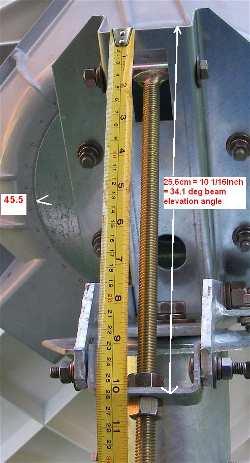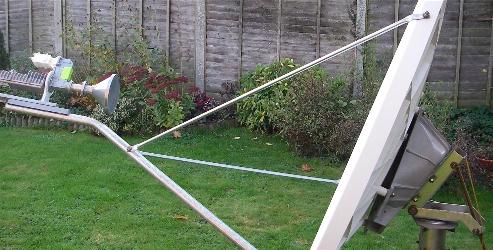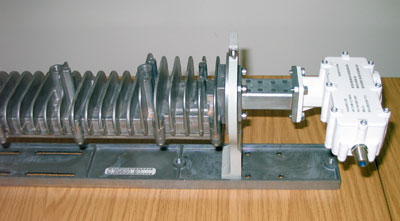Post by Eric Johnston on Aug 5th, 2010 at 10:30pm
Yes, elevation is the up and down adjustment of the big bolt using the two nuts shown below.
Mark a flat on the lower nut with felt tip pen and note the exact measurement before you adjust so you can get back if you lose the satellite and forget how many turns and flats you have applied to the lower nut.
Azimuth is sideways movement. Note measurement of the length of the free end of the side screw before you make any adjustment.
Polarisation involves turning the whole dish using a giant circular scale on the back to approx +45 deg clockwise. The required angle depends on your location. Something like this below. Read the scale. See the +45.5 in the tiny white square on the left of the picture above.
.
Don't adjust polarisation just yet, as to do so you need to calculate the correct angle, then loosen 4 bolts which will make your dish temporarily sag down - you will eventually have to find the satellite again and repeak the elevation. Leave polarisation alone for now.
Note that you are already pointed at the wanted satellite and all you need to do is make very small changes to peak up the azimuth and elevation. If you lose the satellite go back to the original distance measurement settings. If you can't get about 90% then it the time to start worrying about polarisation.
Best regards, Eric.
Mark a flat on the lower nut with felt tip pen and note the exact measurement before you adjust so you can get back if you lose the satellite and forget how many turns and flats you have applied to the lower nut.
Azimuth is sideways movement. Note measurement of the length of the free end of the side screw before you make any adjustment.
Polarisation involves turning the whole dish using a giant circular scale on the back to approx +45 deg clockwise. The required angle depends on your location. Something like this below. Read the scale. See the +45.5 in the tiny white square on the left of the picture above.
.
Don't adjust polarisation just yet, as to do so you need to calculate the correct angle, then loosen 4 bolts which will make your dish temporarily sag down - you will eventually have to find the satellite again and repeak the elevation. Leave polarisation alone for now.
Note that you are already pointed at the wanted satellite and all you need to do is make very small changes to peak up the azimuth and elevation. If you lose the satellite go back to the original distance measurement settings. If you can't get about 90% then it the time to start worrying about polarisation.
Best regards, Eric.



